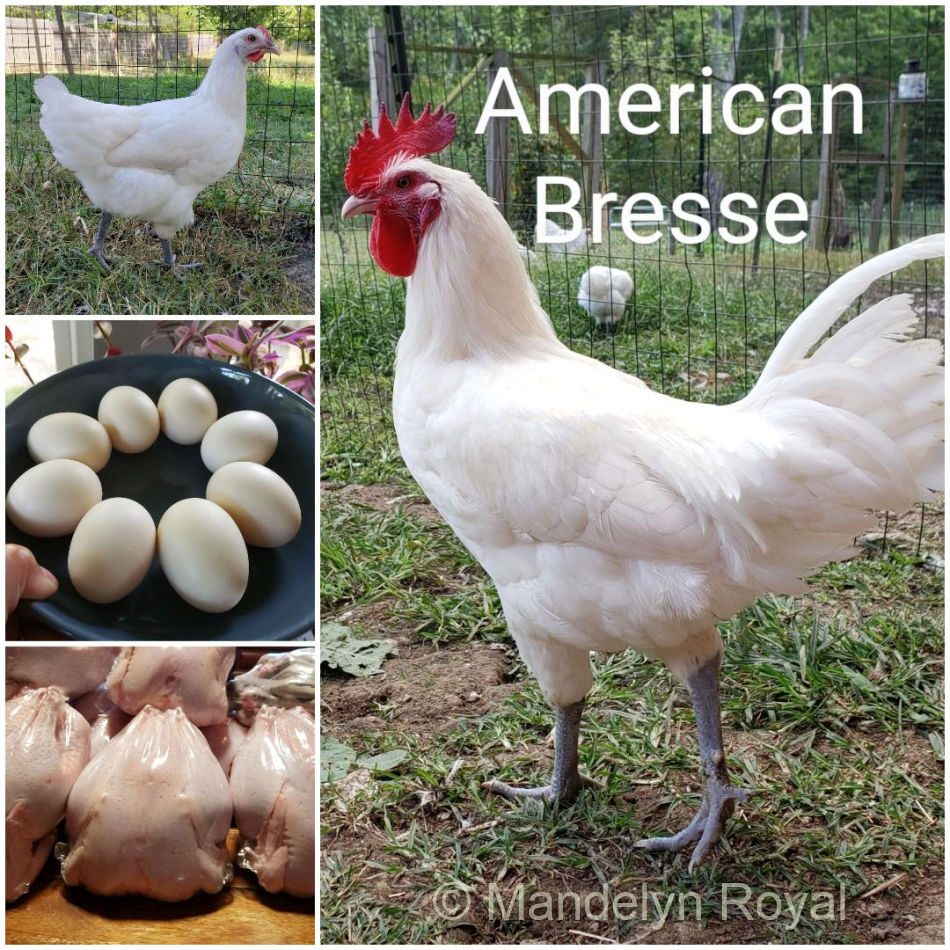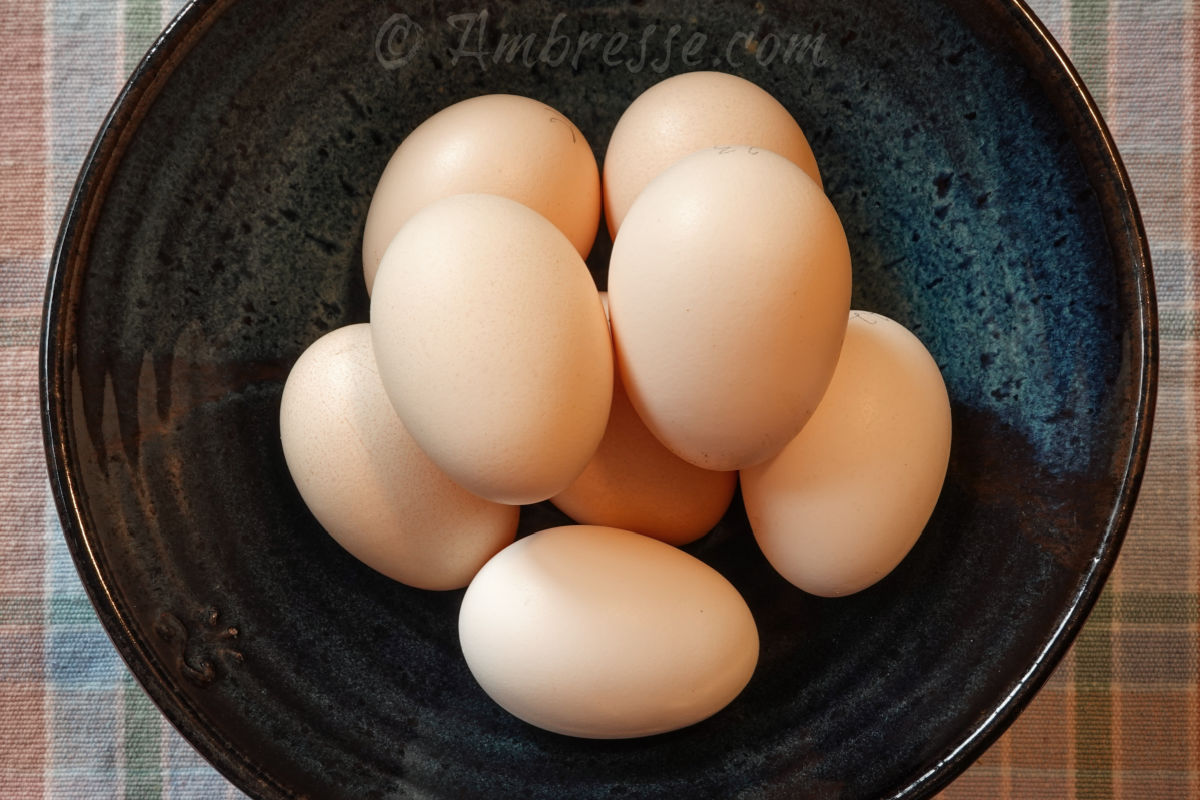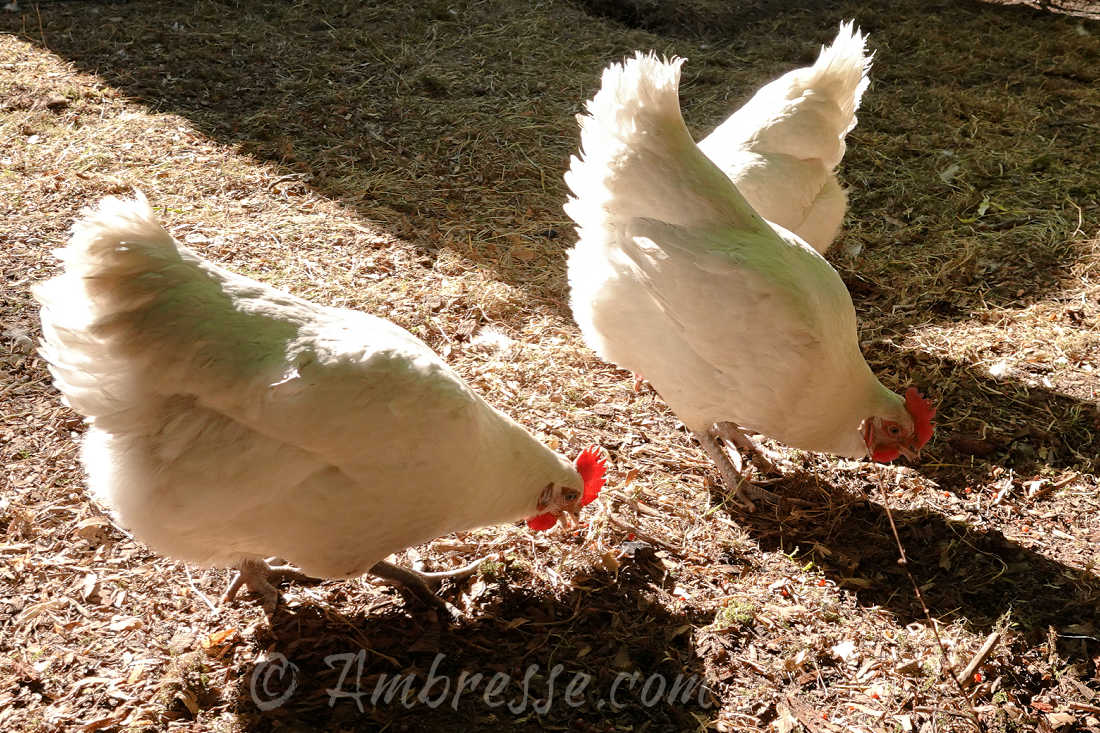American Bresse Eggs
American Bresse Eggs: Great for hatching, baking, and breakfast. General details about Am Bresse eggs, plus check availability of fertile American Bresse hatching eggs from Ambresse Acres or another breeder in your area.

About American Bresse Chicken Eggs
American Bresse chickens typically produce a lot of eggs per season! American Bresse hens are known to lay approximately 250 eggs per season, which is slightly less than Leghorns lay (300 - 320/yr).
ABCs as Egg Layers
Yes, American Bresse are dual-purpose, but if you just want hens that lay lots of eggs, they should fill the bill very nicely!
American Bresse chicken eggs are average to slightly above average in size: 2 - 2.5 ounces, or 56 - 70 grams each. They taste wonderful, but don't all eggs?
American Bresse chicken egg colors are usually described as being "tinted." The tint varies between very light brown, to cream, to barely tinted at all - almost white. See the photo of eggs above from my flock at Ambresse Acres.
The color of the eggs laid by black, blue or splash American Bresse varieties tends to be slightly darker, ranging from a light medium brown, to a very light brown.
In France, French Bresse chickens reportedly lay white eggs.
American Bresse Egg Production
Egg production typically goes into high gear at the end of winter. Spring, summer, and fall is when most eggs are laid. At some point in late autumn or early winter (depending on the geographical location), the hens enter their yearly molt, and egg production drops drastically so their bodies can replace all their feathers.
The hens may enter their molts in a staggered fashion, meaning not every hen at once. The molt tends to last around 1-2 months, and then the hens reenter egg production again in a staggered fashion.
The first year of laying is typically the most productive, with the second year being nearly so. As hens age thereafter, egg production drops year over year.
Preserving American Bresse Eggs
Whether or not you add extra lighting in the coop, the rate of egg-laying tends to drop, sometimes significantly, during the winter. You may find you receive only a few eggs per day.
Luckily, it is possible to set aside and preserve eggs during the abundant months of spring and summer. By preserving eggs during abundance, you'll still have plenty of eggs for breakfast or baking during the winter when eggs may become very scarce.
How to Preserve Eggs: Click the link for seven ways to preserve eggs for up to a year or more. These three are my faves:
- Waterglassing eggs: Use either hydrated lime or sodium silicate (known as water glass) to make a solution that seals the pores in the eggs and maintains the eggs "fresh" for up to a year.
- Freezing raw eggs: Raw eggs will keep for up to one year. Measure them into ice trays; each cube equals approximately 1 egg. You can also scramble and cook the eggs before freezing, though they will be usable for 2-3 months.
- Dehydrating eggs: I like to scramble raw eggs and dehydrate them raw in silicone trays, noting how many eggs went into each tray. When fully dehydrated, vacuum pack and store in a cool dry area. They will last more than a year. Reconstituted raw eggs taste identical to fresh raw, in my judgment. 1/4 cup water reconstitutes 1 egg.
Availability of American Bresse Eggs
The availability of American Bresse hatching eggs is typically highest in the spring and summer. This is true of almost all breeds of chickens, since these seasons are peak reproductive times. Natural forages are fresh and high in protein. Everything is reproducing, including bugs and insects that the chickens feed on. The yearly molt is complete and therefore protein is no longer diverted to build feathers.
The following factors will affect egg-laying:
- Some breeders encourage their chickens to begin and complete their molts during the heat of summer. During a molt, the rate of lay slows down significantly.
- Daylight hours. In the winter in the northern hemisphere, there is far fewer daylight hours. Chickens wake up later and go to bed sooner, and their bodies seem to take a natural rest from egg-laying. At Ambresse Acres, our chickens tend to go into their molts in mid-autumn.
- Ambient lighting. One can boost egg-laying through the winter by adding additional lighting to artificially lengthening the hours of "daylight." By using a timer, the lights can come on at 6 am, and go off at 10 pm. In this manner, the chickens will begin laying immediately after their molt has completed, and keep on laying through the following winter, spring, and summer until their next molt.
At Ambresse Acres, we have taken the approach of going with the natural flow of nature without trying to override the natural slowdowns in egg laying. I think this might allow their bodies to re-stockpile nutrients in preparation for their next season of egg-laying. To me, this might also help mitigate stress on their immune systems and keep them healthier, longer. I dunno, that just is how I am looking at things right now.
What this means for Ambresse Acres, and for many other flocks that don't augment lighting through winter: The rate of lay will hit the basement for a few weeks to a couple months.
If you used to collect a dozen eggs per day, now you may be finding 1-2 eggs per day, if that. But, if you had stockpiled eggs during spring and summer, you'll still have eggs for breakfast omelets and quiches.
Purchasing American Bresse Eggs
Purchasing Fertile American Bresse Hatching Eggs:
We are acquainted with a LOT of excellent American Bresse breeders, and are very happy to refer you to the American Bresse Breeder listings or the American Bresse for Sale pages. Most of these breeders are selling and shipping hatching eggs, day-old chicks, and young birds.
You can hardly go wrong by contacting any of the breeders on the breeder page.
At the same time, I am not able to personally vouch for every one of these breeders, of course. So please do not fail to do your own research and then contact the individual(s) of your choice should you need to obtain some American Bresse hatching eggs.
Purchasing Farm Fresh American Bresse Eating Eggs:
If other reputable American Bresse breeders are anything like us, they are hatching nearly all of their own hatching eggs OR selling and shipping those hatching eggs to their customers. That leaves only the smaller pullet eggs available for consumption.
Honestly, while some people say that American Bresse eggs taste better than other eggs, I'll bet that improved taste is due to the freshness of farm fresh eggs, which will be true of any breed, including leghorns.
The popularity of home flocks means that you are likely able to find fresh eating eggs locally in your own village or neighborhood, and I hope you do! The bad rap that eggs have had in the past has been shown to be fake news. Eggs are very good for you and contribute nutritional building blocks for cellular repair.

- Home
- American Bresse Chickens
- American Bresse Eggs
Overheard...
Tasty Recipe! "I processed my first batch of Bresse... Today I roasted one according (somewhat) to the recipe posted on Ambresse. It was delicious! Tender, moist and succulent... So happy I chose this breed!" (B.E., MN, 12/11/2024).
Success: "I can't believe all the inquiries we get through your website. And it's been a great resource to send people to who are interested in the (AB) breed" (Utangard Farm, NH, 5/5/2025).
Informational: "Your site has the first accurate information about American Bresse chickens that I have seen in English. Thanks for your diligent work" (L. Wooton, NC, 12/17/2024).
Translate This Page
Traduire Cette Page
Traduzca Esta Pagina

News
American Bresse Breed Club web pages can be found under the Breed Club tab on the navigation bar. Any changes in Club status will be posted here!

Photo credit: Mandelyn Royal.



